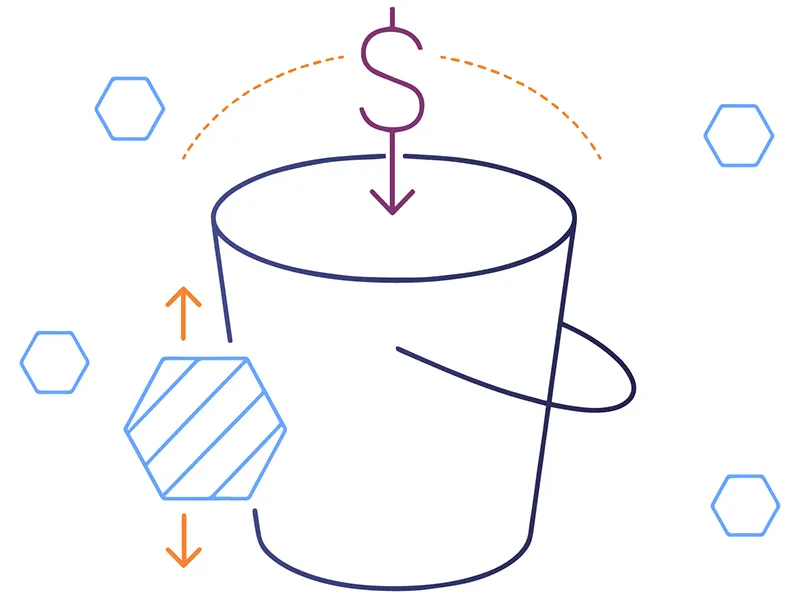Amazon S3 Intelligent-Tiering is one of the most effective ways to reduce cloud storage costs, especially when dealing with unpredictable data access patterns. At Hystax, we help IT teams optimize cloud spending. This guide shows how Amazon S3 Intelligent Tiering works and how to use it effectively to cut costs without compromising data availability or performance.

What is Amazon S3 Intelligent-Tiering?
Amazon S3 Intelligent Tiering is a storage class that automatically moves data between different access tiers based on usage. It’s designed for data with unknown or changing access patterns. You don’t need to predict how often data will be accessed—S3 does it for you and charges you accordingly.
There are no retrieval fees, and the transition between tiers happens automatically behind the scenes. The goal is to store your data in the most cost-effective way possible without manual effort.
Storage tiers in S3 Intelligent-Tiering
Amazon S3 Intelligent Tiering consists of multiple access tiers:
- Frequent Access Tier – For data accessed often. This is the default tier when an object is first uploaded.
- Infrequent Access Tier—This tier offers a lower storage cost for data not accessed for 30 consecutive days.
- Archive Instant Access Tier—This tier is even cheaper but still instantly available for data not accessed in 90 days.
- Optional Archive Access & Deep Archive Tiers – These offer the lowest prices but require restoration times of minutes to hours.
This tiering allows AWS to optimize storage costs based on how data is used over time.
Benefits of using Intelligent-Tiering
Cost savings
No retrieval fees
Unlike S3 Glacier, Intelligent-Tiering does not charge you for data retrieval.
Automatic optimization
AWS monitors your data and shifts it between tiers without any manual work.
Seamless performance
Data in all tiers (except optional archive ones) is instantly accessible with no performance lag.
Want to see how much you can save with Intelligent-Tiering
and other optimization techniques?
Enter your business email to explore OptScale capabilities as a FinOps platform
Thank you for your request!
We will be in touch soon.
We respect your privacy. See our Privacy Policy. You can unsubscribe at any time.
When to use S3 Intelligent-Tiering

How to enable S3 Intelligent-Tiering
You can use Intelligent-Tiering in a few ways:
1. Set it as default during upload
When uploading data to Amazon S3, use the AWS Console, CLI, or API to choose Intelligent Tiering as the storage class.
2. Use lifecycle policies
Already storing data in other classes? You can create lifecycle rules that automatically transition objects to intelligent tiering after a set number of days. This works great for predictable aging data, like logs or exports.
3. Apply it selectively
You can apply Intelligent-Tiering only to specific buckets, prefixes, or object tags to control costs more granularly.
Best practices to maximize savings
1. Target large objects
AWS doesn’t tier files smaller than 128 KB, so large files should be prioritized for intelligent tiering.
2. Monitor the monitoring fees
There’s a small monitoring fee (~$0.0025 per 1,000 objects/month). If you store many small objects, consider if the savings outweigh the monitoring cost.
3. Combine with FinOps visibility
Use a cloud cost optimization platform like Hystax OptScale to track usage patterns and ensure you’re storing data cost-efficiently.
4. Set lifecycle rules with intention
For frequently accessed data, avoid unnecessary transitions or deep archive moves. Tune lifecycle settings to match your organization’s data needs.
5. Analyze access patterns
Review access logs to understand how often data is accessed. S3 Storage Lens or OptScale can help with this.
Cost considerations
When used correctly, the savings far outweigh the extra monitoring costs—especially for datasets with uneven usage.
Common use cases
- Cloud-native applications with variable data usage
- Machine learning datasets that aren’t accessed daily
- Teams may need logs, media files, and exports at any time
- Organizations must retain compliance data, even if they rarely access it
Final thoughts
S3 Intelligent Tiering is a smart, low-effort way to cut AWS storage costs. It’s perfect for businesses looking to simplify storage management and automate cost optimization.
At Hystax, we help organizations implement FinOps best practices and gain complete visibility into their cloud spending. Intelligent-Tiering is one of many tools you can leverage for smart storage decisions.
✅Boost AWS S3 efficiency with Duplicate Object Finder by OptScale—remove redundant data and reduce costs for better performance →


